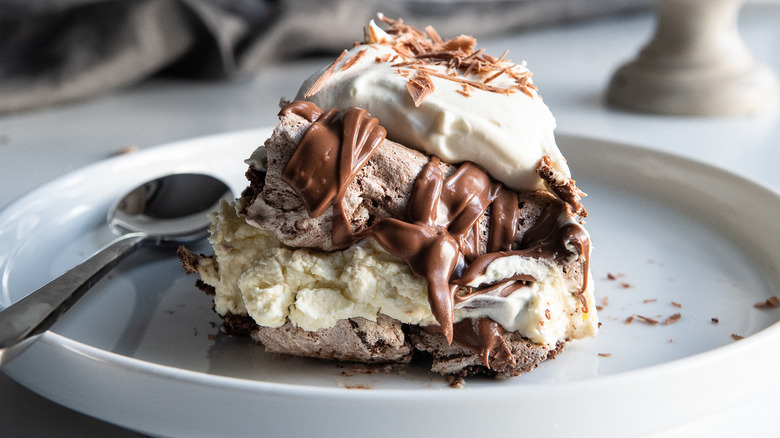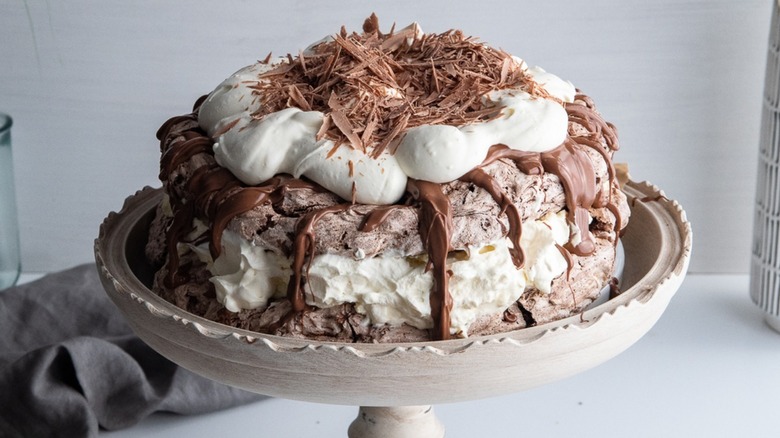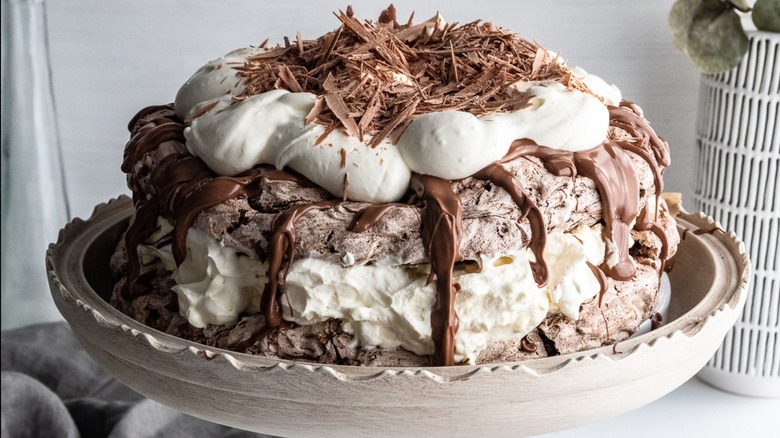Chocolate Pavlova Recipe
Have you been searching for decadent dessert ideas? You may find this hidden in an international cookbook, but we are convinced you'll love our chocolate pavlova rendition. Jennine Bryant, food photog and recipe developer prepared this delicacy, and it is just as decadent as it sounds. With the combination of whipped egg whites, rich cocoa, and whipped cream, this is the most sensational way to say "I Love You" or "Congrats".
So, where did pavlova come from? There isn't a definitive answer, but Bryant has some ideas: "The origin of the pavlova is somewhat hotly debated, there doesn't seem to be a clear origin story. A lot of different old recipes refer to "foam like" cakes or call themselves pavlovas, but aren't what we know today as a meringue based cake. Various countries lay claim to "meringues and cream" as a concept, with Australia and New Zealand coming up a lot," Bryant explains. "I think my favourite origin story is that it was created for the famous ballet dancer, Anna Pavlova," she adds. Regardless of where pavlova came from, it is one delicious dessert, and this chocolate variation takes things to a whole new level.
Gather the ingredients for chocolate pavlova
Before you do anything, you'll want to make sure that you have the right ingredients for this recipe. To begin, drop by the market and select large eggs (kept temporarily at room temperature), granulated sugar, cocoa powder, and, surprisingly, balsamic vinegar. This recipe also calls for dark chocolate, whipping cream, vanilla extract, and milk chocolate.
Bryant narrated her inspiration for this dessert. "My mum has been making chocolate pavlovas since I was little, but normally only one layer, with cream and raspberries on top. I love chocolate, dramatic cakes, and also the aesthetic of stacked pavlovas, so I thought I'd give it a go," she shared.
Separate and beat the egg whites
Commence the recipe by setting the oven to preheat at 350 F. As the oven warms, line a large baking tray with parchment paper. Use your best method to separate out the egg whites from the yolks. Add the egg whites into a clean mixing bowl and beat until they become foamy and stiff. "I keep my mixer on a high speed the whole time I'm beating the egg whites and meringue," Bryant explains. "Sometimes I reduce the speed slightly when adding the sugar because when it's going that fast it can throw a whole lot of the sugar straight back out!"
Start adding the sugar
With the beaten egg whites still the mixing bowl, without pausing the mixer, slowly begin dropping the sugar in a spoonful at a time. Once you've measured a full cup of sugar into the mix, the meringue should be thick and glossy. If the meringue stays stuck at the bottom of the bowl when it is turned upside down, then it is ready. The sugar should also be fully combined, so the mixture should not feel gritty between your fingertips — if it is, beat for a few more minutes until the mixture is smooth and silky.
Add the chocolate
It wouldn't be a chocolate pavlova without some chocolate, right? Sieve 1 tablespoon of cocoa powder and gently fold it into the whipped egg whites. Drizzle in 1 teaspoon of balsamic vinegar along with the ½ cup of chopped dark chocolate. "Do not over mix, it's okay if the meringue is not uniform in colour," Bryant advises.
After folding the ingredients together, divide the meringue into two. Mound the mixtures into two equal-sized, fat circles on the parchment-lined baking tray. Use a spoon to smooth out and shape the meringues. Place them directly in the oven, immediately reducing the temperature to 300 F. Bake the meringue mounds for one hour. Afterwards, turn the oven off and slightly open the door. Allow the meringues to cool completely before removing them.
Layer the whipped cream and merignue
In a clean bowl, whisk up the whipping cream until it is thick. Trickle in ½ teaspoon of the vanilla extract for flavoring. Place one of the baked pavlova meringues on a plate or a cake stand as the foundational layer. Evenly heap half of the whipped cream atop the first meringue mound. Drizzle a bit of the melted milk chocolate on top. Top it with the second pavlova meringue, drizzling the rest of the melted chocolate atop of that layer and finally adding the top layer of cream. Finish off the pavlova with some chocolate shavings and serve immediately. Our developer says you don't have to be an expert to achieve this, "I used a sharp knife and a block of chocolate, nothing fancy. Just angle the blade and then pull it gently across the top of the chocolate and you'll get thin shavings!"
Relish the richness
This exquisite dessert will be the talk of the engagement. No matter the event, your guests and family will indulge with excitement. "I would serve this either for someone's birthday, or a special occasion, a celebration or a nice dinner party," Bryant says. "It's a bit too fancy (and too big, at least for me and my husband alone!) for everyday snacking, but saying that, it would be totally possible to make a load of mini meringues with the recipe, instead of two big ones," she added. This is best served right away. If necessary, "It will need to be covered well in cling film or put in an airtight container and stored in the fridge," Bryant suggests. Now you have a tasty, homemade chocolate pavlova to relish for days to come — enjoy!

- 4 large eggs, room temperature
- 1 cup granulated sugar
- 1 tablespoon cocoa powder, sieved
- 1 teaspoon balsamic vinegar
- ½ cup dark chocolate, finely chopped + extra for decoration
- 2 ½ cups whipping cream
- ½ teaspoon vanilla extract
- ½ cup milk chocolate, melted
- Preheat the oven to 350 F and line a large tray with parchment paper.
- Separate out the egg whites from the egg yolks, and then add the egg whites to a clean mixing bowl. Beat until they are foamy and stiff.
- Slowly mix in the sugar a spoonful at a time, until all of the sugar has been added and the meringue is thick and glossy. If the meringue stays stuck at the bottom of the bowl when it is turned upside down, it is ready. The sugar should also be fully combined, so the mixture should not feel gritty between your fingertips — if it is, beat for a few more minutes until the mixture is smooth and silky.
- Gently fold in the cocoa powder, balsamic vinegar, and chopped dark chocolate. Do not over-mix — it's okay if the meringue is not uniform in color.
- Divide the meringue into two and mound the mixture into two equal-sized, fat circles on the baking tray. Use a spoon to smooth out and shape the meringues, then place them in the oven and immediately reduce the temperature to 300 F. Cook the meringues for 1 hour.
- After an hour, turn off the oven and open the oven door slightly. Allow the meringues to cool completely before taking them out of the oven.
- In a clean bowl, whisk up the whipping cream until it is thick and mix in the vanilla extract.
- Place one of the pavlova meringues on a plate or a cake stand, and then heap with half of the whipped cream. Drizzle a little of the melted chocolate on top, then top with the second pavlova meringue, the rest of the melted chocolate, and then the cream. Finish off the pavlova with some chocolate shavings and serve immediately.






